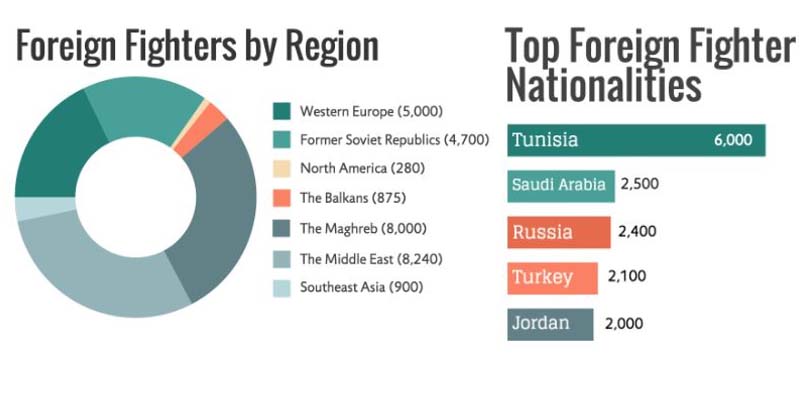More than 31,000 foreign fighters have travelled to Syria and Iraq to fight with ISIS, a disturbing new report has revealed

Based on The Soufan Group’s report; Written by Mario Andrijasevic exclusively for SouthFront
Back in June 2014, The Soufan Group released its initial Foreign Fighters in Syria report, which identified approximately 12,000 foreign fighters from 81 countries.
Nearly 18 months later, despite sustained international effort to contain the Islamic State and stem the flow of militants traveling to Syria, the number of foreign fighters has more than doubled.
Based on its own investigation, The Soufan Group has calculated that between 27,000 and 31,000 people have traveled to Syria and Iraq to join the Islamic State and other violent extremist groups from at least 86 countries.
Foreign fighters from Russia and Central Asia have shown a significant rise; some estimates suggest a near 300% increase in known fighters since June 2014.
So where are all the ISIS fighters coming from?

Tunisians, Saudis, and Jordanians continue to outnumber other national contingents, although a reverse flow to North Africa may alter the balance within the Arab group.
The foreign fighter phenomenon in Iraq and Syria is truly global, with at least 86 countries seeing at least one of their citizens or residents travel to Syria to fight for extremist groups there, primarily for the Islamic State. But the flow is neither uniform by region nor by country, regardless of the pool of residents who may be susceptible to the Islamic State’s appeal.
The great majority of foreign fighters in Iraq and Syria are from Arab countries, with both the Middle East and the Maghreb supplying large numbers. As of October 2015, an estimated 6,000 fighters had traveled to Syria from Tunisia.
According to Tunisian authorities, 700 Tunisian women have traveled to Syria to join the Islamic State and other groups. Yes, women are also very important to ISIS. It is expected from them to fulfill their religious duty to the caliphate by being mothers and helping to populate a future Islamic State in the Middle East.
It is reported that ‘ISIS pays their fighters $200 a month salary, which is a lot of money for unemployed people coming from poor, underdeveloped states where the prospect of a well-paying job is effectively zero.
As with the former Soviet republics, the Balkans have also historically been home to a small but sizable population of violent Islamist extremists. This is particularly true of countries in the western Balkans with majority Muslim populations.
Data on foreign fighters from countries within the Horn of Africa is limited. Somalia, home to al-Shabaab, which is part of al-Qaeda, reportedly had around 70 fighters in Syria as of January 2015.
In September 2015, a Sudanese government official made a statement that 70 fighters from Sudan had traveled to Syria.
For some countries, such as Libya and Tunisia, the phenomenon of foreign fighter hubs is even more apparent. In Libya, the eastern coastal region—especially Benghazi and Derna—is known as a hotbed for recruitment. In Tunisia, the city of Ben Gardane has provided the largest number of foreign fighters, despite being a city of less than 80,000.
The secular nature of western European countries like France and Belgium, which top the poll for the highest number of fighters per capita, coupled with a sense of marginalization among immigrant communities, especially those from North Africa, appear to have played a role in the radicalization process.

The Islamic State offers them a new identity that is less determined by their past than by their potential contribution in the future.
Official estimates from French authorities indicate around 1,700 individuals had left France to join the fighting as of October 2015. Another 760 fighters from the United Kingdom and 760 from Germany had gone to Syria as of November 2015, along with 470 from Belgium as of October 2015.
Based on these estimates, almost 3,700 of the total 5,000+ European Union foreign fighter contingent come from just four countries.
Compared to the substantial increases in foreign fighters from western European countries, the flow of foreign fighters from the Americas has remained relatively stable and far lower in terms of per capita numbers. According to FBI Director James Comey, a total of 250 Americans had traveled or attempted to travel to Syria as of September 2015, with only about 150 being successful.





